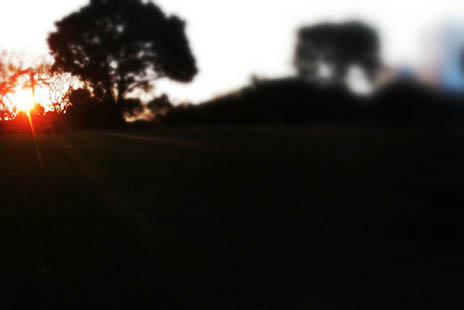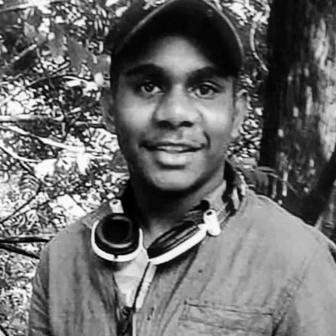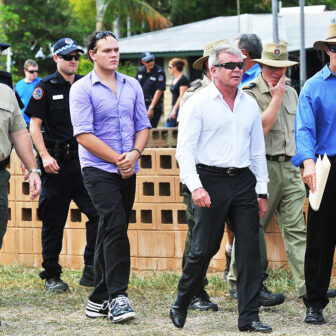IT IS ENTIRELY possible to experience Darwin as something of a pleasure dome, a world of genteel evasions and married midriffs. On balmy tropical evenings in the dry season, the town lights up with creative festivals, racing carnivals and galas. There are award-winning restaurants and yacht voyages offering champagne by sunset, hipster jewellery and flowing silks at the bohemian events, plunging necklines and upswept hairstyles where the more expensive alcohol flows.
To explore the Darwin that is unknown to any tourist, I opt instead for a bird’s-eye view from an ultralight aircraft. The small band of pilots of these frail-looking craft keep their machines at a small field at Noonamah, down the Stuart Highway, past Darwin’s industrial estates and near the first of the region’s crocodile farms. As we puttered down the airfield, leaving early to avoid the turbulent thermals, wallabies bounded past and wood pigeons piped a farewell refrain. An ultralight flies low and slow, revealing a perspective that hill-less Darwin otherwise cannot offer.
A thousand feet up and the tough, delicate topography of Darwin comes into view, a place of military zones, industrial sites and back-to-the-future incarceration compounds. There is the huge chunk of habitable land consumed by the airport; the mangroves as they hold the slow-drowning delta system in fragile check; the inlets of East and West arm, showing how close to inundation Darwin’s harbour has become. Between the deltas, on slightly higher land, five-acre rural blocks and allotments scraped over for their gravel and sand. Extractive sites are everywhere, some current, some abandoned – miniature versions of their bigger cousins, the open-pit mines. Old quarries are filled with water, sluice pits of unnatural pink or milky green.
It is not just the gravel diggers who have scraped and levelled. There are raw earth patches and building works in all directions. My pilot points out the new detention centre, a skinny village of metal demountables stacked one on top of the other, 1500 rooms with two people apiece. This is the Wickham Point Development, destined to be Australia’s largest on-land immigration detention centre. The Paspaley family is a majority shareholder, farming people instead of pearls. They join another money-maker, “Foxy” Robinson, for whom public hostility to asylum seekers is a more practical affair of financial opportunity. One of Foxy’s compounds stands to the left of the entrance road to Darwin airport. A series of navy blue demountables stacked one atop another, joined by stairs and narrow balconies, they can easily be converted into temporary accommodation for “fly-in, fly-out,” or FIFO, workers by removing the barbed wire fencing and calling it a hotel.
The new immigration detention centre sits astride old prawn farms, shallow rectangles of dirty salt water framed by mud embankments, the abandoned farming ideas of earlier times. It is being built at a site refused by the Japanese flagship oil and gas extraction corporation Inpex as too cruel for its future FIFO workers, being so breathless and full of biting insects.
We fly over another site, this one the new prison complex, being built to cope with the Territory’s burgeoning prison population. The building carapaces are in a circle divided into sections – like an orange that’s been halved then had three segments at a time pulled away from the pith – occupied by an inner ringlet of watchtowers. It is a perfect Benthamite “panopticon”: an apparatus of social discipline made famous by philosopher Michel Foucault. Jailing people (like assaulting people, rolling cars or drinking a lot) is something the Northern Territory does exceptionally well. The signs of trauma are everywhere: little plastic flower shrines fixed to electricity poles and road signs, sun-faded and dusty; a makeshift cross with felt-pen hatchings saying a loved one died right here. And in the jails, different kinds of human wreckage. Nationally in 2013, reports the Australian Bureau of Statistics, the average daily imprisonment rate was 172 prisoners per 100,000 adult population. The Northern Territory: 889 prisoners per 100,000, more than four times the Australian average. There’s no mistaking the racial character of the prisoner population either. Eighty per cent of adult prisoners are Indigenous, a slight improvement on Darwin’s juvenile detention centre, where less than 10 per cent of the teenage inmates are not Indigenous.
One more thing can be added to Darwin’s list of firsts: it can also boast Australia’s highest rates of homelessness. As we zoom over the Howard Springs region, an even more barren site appears, this one lined by rows of single-storey demountables, densely packed together in regimented blocks, only metres apart.
“What’s that?” I yell into the helmet mike, over the drone of the aircraft engine at my back.
“That’s the new village for workers for the Inpex gas plant,” the pilot shouts back. “Locals keep suggesting it should be turned into an old people’s home after they’re finished with it.”
Whoever suggests this obviously hasn’t taken a close look at what they’re talking about, I muse. Perhaps they’ve taken the cute term “accommodation village” to imagine something more salubrious than the Lego-land fortress of asphalt, dongas, kitchen block, tavern and dining halls below me. It has been designed so that Inpex workers will be kept to a tight schedule, following a Japanese Fordist model that echoes the organised tent city that lined Port Darwin in the early decades of settlement, when Goyder frogmarched his work squadrons to map and subdivide 270,000 hectares of strange land in nine months flat.
In future the Inpex accommodation village will be greened with instant lawns and transplanted trees. It will have a cricket pitch, swimming pool and basketball courts. An onsite medical centre is up and running, together with a cinema complex. There is a bus depot too, to transport workers to and from the processing centre, to and from the airport, to and from the town; no need to clog the roads with the expected 3500 FIFO workers. The Inpex workers are meant to arrive, work, depart. The facilities will ensure that their like or dislike of Darwin itself will be of no real consequence, even as their presence helps price-gouge the real estate market.
The plan is to suck the gas and condensates from the Ichthys gas field off the Kimberley coastline in Western Australia – forty years’ worth, they say – and squeeze what cannot be immediately processed along the longest subsea pipeline in the southern hemisphere, nearly 900 kilometres’ worth, all the way to Darwin. There, at a facility called Blaydin Point (better known to locals as the Middle Arm Peninsula), the gas will be cooled to below minus 161 degrees Celsius, a process that requires enormous energy inputs, even outside the tropics. Thus compressed into liquefied natural gas, or LNG, it will be shipped in tankers to Japan and regasified, supplying more than 10 per cent of Japan’s gas imports. Sucked, squeezed, shipped: does this make it like the fishing industry? From the Greek word for fish, “ichthys” also names the two curved strokes that outline the shape of a fish in Christian symbolism. Perhaps the metaphor takes us from Jesus, the giver of fish, to Japan, the taker of gas, via Darwin, the eager disciple.
Ichthys is the largest private capital investment in Australian history – a coup for the Territory, which won the decision over rival Western Australia by not demanding that some of the gas be reserved for domestic consumption. Onshore processing in Western Australia invokes a 15 per cent domestic gas reservation policy for domestic purchasers (including local industries). Technically, the gas isn’t owned by the Territory, so reserving any would require paying royalties to Western Australia via the Commonwealth, as the Territory’s financial patron, and there is no word on that either. At any rate, the next fifteen years’ worth of LNG production has already been sold to overseas buyers. Instead, as locals protest the continual dredging of the harbour and destruction of recreational fishing zones, vast economic benefits are promised to outweigh any drawbacks.
Looking down from the sky, the future of the city hails its past. Habits of incarceration are buried deep in Darwin’s bones, from the earliest days of settlement, when compounds were filled with immigrant–Aboriginal progeny and jails spilt over with the unwanted, to now, where new reservations for brown-skinned asylum seekers and worker enclaves are being erected at speed and the jail is quadrupled in size.
We see a cluster of satellite domes like a toadstool forest dotting the shoreline at Shoal Bay, inaccessible. We are not allowed to fly over those. The route we fly is hedged in by invisible fences, blocking massive grids from trespass, difficult to see but as real as barred gates with sentry guards. The divided sky mimics Darwin’s lesser-known status as a garrison town: there but not there, known but not known, remembered then forgotten.
Mango orchards and market gardens interrupt the military–industrial complexes. Buckley Road in Darwin’s Humpty Doo is known to horticulturists as Little Vietnam. A mango business goes by the name of Saigon Farm. A patchwork emerges. Fields of bok choy, dragon fruit, bitter melon, snake and winged beans open beneath us, the hard-earned results of Vietnamese farmers pulling food from this tough land. These “boat people” had arrived in vessels held together by hope and despair, to a country that, back then, had welcomed them. They transformed Darwin into a place where multiculturalism is consumed by tourists and locals alike, in pork ball satays with their halo of garlic fumes; fresh-caught mud crabs, still live and vengeful, hoping to wrest a claw free of the plastic ties holding them prisoner in styrofoam boxes; pho soup broth simmering in giant pots, ready to be ladled onto bowls of rice noodles; and soft rice paper rolls spiced with chilli, crushed peanut and fragrant mints. Funny how the fall of Saigon to the Vietnam People’s Army in 1975 led to this: a Vietnamese refugee resettlement program that utterly changed the town. Exotic ginger species and other ornamental plants transformed gardens while Vietnamese horticulture made the markets the tourist paradise they are today.
We pass over the new housing estates being built in Palmerston for people getting a foothold in the expensive real estate market. The besser-block constructions push to their boundaries. Between fence and house there’s room only for air-conditioning units, a neighbourhood of machines permanently exchanging hot-air gossip. Without air-conditioning, these houses would be unliveable for large chunks of the year. It is the despair of local architects, who lament the lack of environmental design. Yet the boxed panorama below represents the desires of the sojourning majority, and what the majority demands, the market supplies. It has got to the point where the highest energy efficiency ratings are awarded to houses that reduce airflow and insulate for air-conditioning. It is an energy efficiency system that penalises louvres in favour of small, double-glazed sliding windows and thick cement walls.
Over to our northwest from the skies of Palmerston we can see the spiked high-rises of Darwin’s CBD. Glimmerglass office towers and accommodation complexes sprout where the town’s former low-density housing and oil tanks used to be. The city does not embrace its ocean necklace but turns its buildings inward and skyward, rewarding the well-heeled with the cooling effects of air-conditioning, hotel pools, turquoise views and underground carparks. Only one stretch of waterfront is permanently reserved for public use in the CBD – the Esplanade, a narrow strip of green that miraculously survived from the days of Goyder’s surveys on.
New Darwin represents the bonanza and cataclysm that is the dazzling Inpex/military buildup. Whole buildings in the many new high-rise complexes in and around the old peninsula are filled with strangers, non-resident workers the fastest-growing demographic. Speculative pricing and negatively geared investors have made Darwin’s real estate market a rival to Sydney’s. Those with the cash to purchase have watched their accounts grow fat. For others, the skyrocketing prices weigh their futures down. Darwin offers work, but not the hope of a home, the toll price for living in a boomtown. It has become a prosperous, unequal city. The town’s repeated failure to plan infrastructure around future residential needs is biting back with a vengeance: old sewerage systems are choking under the load; new run-offs create swamps in built-in residential zones; a third dam is needed; the electricity network generates higher pricing to pay for upgrades after years of neglect.
Some locals eye off the hunk of higher land sitting in Darwin’s belly, decorated by languorous airstrips able to handle the heavy, slow-launching B52 bombers, and imagine this above-sea-level and centrally located land being opened for residential development. There are no military planes on the tarmac when I go to meet the commanding officer of 13 Squadron at Darwin’s RAAF base: the dry season exercises have been over for some weeks. It adds to the sense of availability. The red-haired CO greets me in full blues, gold buttons gleaming, for the governor-general will be visiting later that day. We meet in vintage RAAF headquarters next to the runway, an austere fibreboard building from the 1930s, when extravagant ceiling heights compensated for constricted horizontal space.
Of his twenty-three years in the RAAF, thirteen have been spent in and out of Darwin. His perspective takes in other places – Somalia, Afghanistan – but his enthusiasm for this, the largest runway and most capable airfield the RAAF operates in Australia, has not lessened a jot. He knows every inch of this airfield, from the decaying pipes underneath to where the ordnances are stockpiled. When he first came to Darwin, the barracks and airfield were on the outskirts of town. Today, residential and light industrial estates nibble like rats on all sides.
He reminds me that there has been a RAAF presence in Darwin since the 1940s, and that they have always enjoyed warm community acceptance, albeit that more people might complain now about the noise of fighter jets taking off for their practice manoeuvres every June. I nod, knowing how our whole house shakes and talk is stopped as the air explodes with jet fighter noise. They set off in relays, so close you can train binoculars onto the wings and name the craft – heaven for planespotters. We agree it is unusual to have an international airfield and military base smack in the middle of a capital city, but when I ask whether the airfield will ever be made available for residential development, he shakes his head, chuckling sympathetically.
“The airport here is highly capable, with a large runway able to support just about any aircraft ever built.”
Shifting the airfield would be untenable in his opinion, costing billions of dollars and adding at least an hour’s drive at either end of travel times. It is the military purpose that gives this small town its high-end airfield in the first place – a reminder, if one was needed, of how deeply entwined Darwin’s existence is with that of national defence. •




